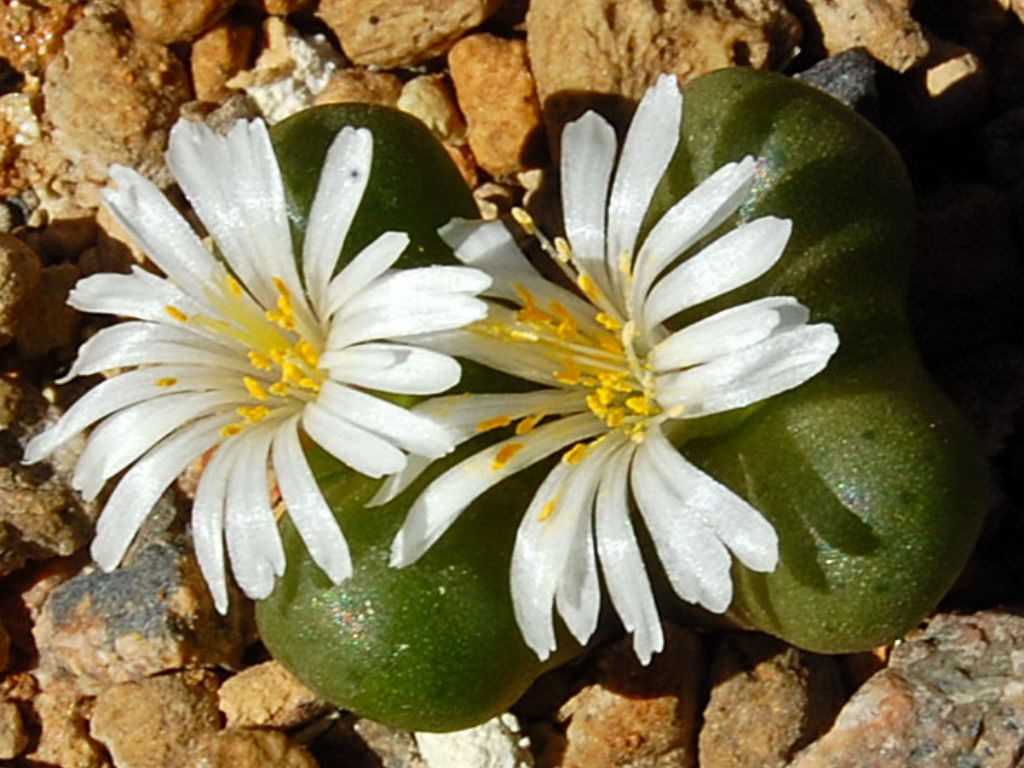Scientific Name
Conophytum roodiae N.E.Br.
Synonym(s)
Conophytum roodiae subsp. roodiae, Conophytum cylindratum var. primosii, Conophytum hallii, Conophytum primosii, Conophytum rubroniveum
Scientific Classification
Family: Aizoaceae
Subfamily: Ruschioideae
Tribe: Ruschieae
Genus: Conophytum
Origin
This species is native to South Africa (the Namaqualand region of the Northern Cape).
Description
Conophytum roodiae is a dwarf succulent that forms dense clusters of unequal bodies composed of two fleshy, almost entirely fused leaves. The clusters are up to 2 inches (5 cm) in diameter. Bodies are short cylindrical with a convex or truncate apex, up to 0.8 inches (2 cm) tall, and up to 0.4 inches (1 cm) in diameter. They are green, reddish-brown to beet red, shiny when actively growing, and often irregularly ridged or spotted. Flowers are diurnal, white to pink, and appear in late summer and fall.
Etymology
The specific epithet "roodiae" honors Mrs. Petrusa Benjamina Rood (1861-1946), a South African plant collector who sent seeds, succulents, and bulbous plants to botanists such as Illtyd Buller Pole Evans, Neville Stuart Pillans, Nicholas Edward Brown, and Thomas Nicholas Leslie.

How to Grow and Care for Conophytum roodiae
Light: Most Conophytums need bright light but do not like too much intense sunlight. To avoid sunburn, place them in a position to receive a few hours of full sun in cooler periods of the day.
Soil: These plants thrive best in a porous growing medium that will drain quickly. Use a commercial soil mix specially designed for growing succulents or make your own.
Hardiness: Conophytum roodiae can withstand temperatures as low as 35 to 50 °F (1.7 to 10 °C), USDA hardiness zones 10b to 11b.
Watering: When Conophytums go dormant in the spring, they require little or no water. In the fall, when plants will begin growing, it is safe to water deeply, allowing the soil to dry before watering again.
Fertilizing: Conophytums are light feeders and do not need fertilizer if it is repotted every two years.
Repotting: These succulents will benefit from repotting. The best time to repot a Conophytum is at the beginning of a period of active growth.
Propagation: Conophytums are easily propagated by division. They can also be grown from seeds.
Learn more at How to Grow and Care for Conophytum.
Toxicity of Conophytum roodiae
Conophytums are non-toxic and safe to grow around children and pets.
Links
- Back to genus Conophytum
- Succupedia: Browse succulents by Scientific Name, Common Name, Genus, Family, USDA Hardiness Zone, Origin, or cacti by Genus
Photo Gallery
Click on a photo to see a larger version.



